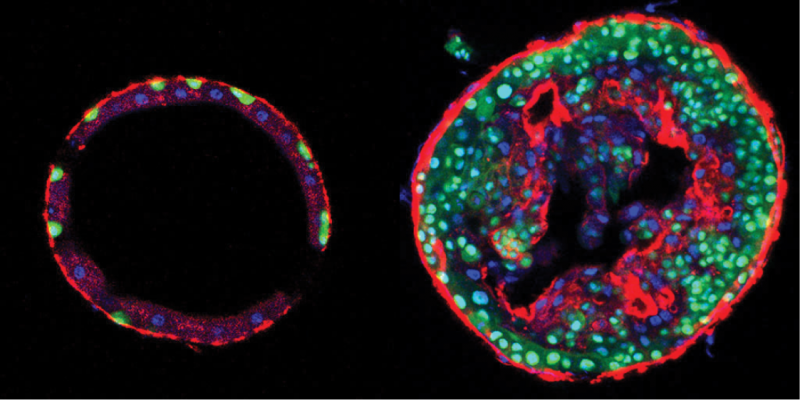Intracellular calcium integrates complex signaling to control stem cell activity

Adult stem cells ensure continuous regeneration of tissues throughout our entire life. But the activity of these stem cells has to be carefully controlled in order to support regeneration without cancer. How this balanced control is achieved and maintained as the organism ages remains a critical question in stem cell biology. Publishing in Nature, researchers at the Buck Institute have identified a new mode of stem cell regulation. Working in the fly gut, senior scientist Heinrich Jasper, PhD, and colleagues show that stem cells adjust their proliferative activity in response to a wide variety of signals via intracellular calcium (Ca2+) signaling. Mechanisms that control the intracellular Ca2+ concentration and proteins that respond to intracellular Ca2+ changes thus emerge as master regulators of stem cell activity.
Adult stem cells in the gut exist in a very active environment, they are continually bombarded with signals - from diet, the microbiome, and from invading bacteria and other stressors. Should the cells spring into regenerative action and divide or remain poised for future needs? Jasper says a Ca2+ sensitive gene regulatory system integrates these stimuli to control intestinal proliferation by influencing the oscillation of Ca2+ levels within the cells.
"These findings help explain how stem cells are able to respond to such a wide range of stimuli," said Jasper, who is also the Chief Scientific Officer at the Buck Institute. "The fact that one variable - Ca2+ - is integrating all of these signals was quite an exciting and surprising discovery in stem cell biology with implications for our understanding of various cancers and a range of degenerative diseases."
Postdoctoral fellow Hansong Deng, PhD, determined the wide-ranging significance of Ca2+ signaling after discovering that intestinal stem cells have receptors that sense L-glutamate, and that dietary L-glutamate stimulated stem cell division and gut growth in the flies. Deng teamed up with Buck Research Professor Akos Gerencser, PhD, (co-director of the Institute's imaging core) who was able to image live stem cells in the fly gut. Surprisingly, they discovered that Ca2+ levels oscillate regularly in stem cells and that L-glutamate regulates stem cell activity by triggering a sustained increase of Ca2+ within the cell.
Research showed that this change in Ca2+ levels in stem cells was not limited to the response to L-glutamate, but was also observed when these cells became activated in response to other stimuli, including infection and tissue damage. In addition, the scientists found that elevating Ca2+ by genetically perturbing Ca2+ pumps in the stem cells resulted in a strong, continuous proliferative response.
A sustained elevated intracellular Ca2+ concentration thus emerged as a universal and required characteristic of activated stem cells, and Deng found that the activation of stem cells by Ca2+ was accomplished by Ca2+-sensitive protein phosphates and transcription factors. The researchers say this universal role of Ca2+ in stem cell activation suggests that these cells use the intracellular Ca2+ concentration as a gauge to respond dynamically to the multitude of signals vying for their attention.
Jasper says that in the future, his lab plans to explore the role of this regulatory system in influencing stem cell based diseases and age-related dysfunctions in the gut and other high-turnover tissues, adding that the work has important implications for how environmental challenges influence such diseases. L-glutamate, for example, is the most abundant naturally-occurring amino acid in the body and is involved in many metabolic processes. Dietary sources of L-glutamate include beef, chicken, fish and eggs. Its sodium salt is also known as the flavor enhancer MSG, which was fed to the flies in this study. Jasper says this study provides an interesting new angle to our understanding of the effects of the widely-used ingredient. "We've shown in the fly that supplementing a protein-restricted diet with MSG stimulates the proliferation of stem cells. Supplementing the same diet with high concentrations of MSG, on the other hand, impaired stem cell activity, indicating that at these high concentrations MSG may cause stem cell toxicity. Whether the effect of MSG on stem cell proliferation is a good or bad thing is another story," he said. "Supplementing the diet with low levels of MSG might just be supporting regeneration or it might be causing stem cells to proliferate too much, facilitating the development of gastrointestinal cancers. It's an open question that needs more study, especially in vertebrates."
More information: Hansong Deng et al. Signal integration by Ca2+ regulates intestinal stem-cell activity, Nature (2015). DOI: 10.1038/nature16170
Journal information: Nature
Provided by Buck Institute for Research on Aging


















